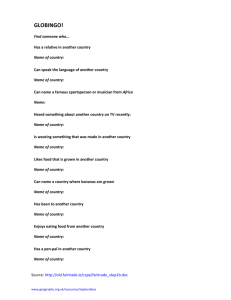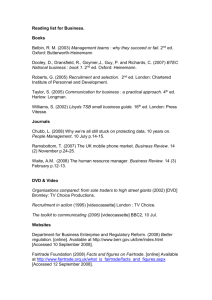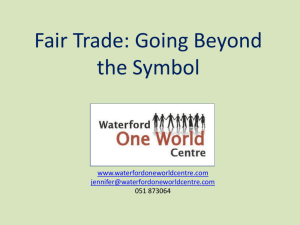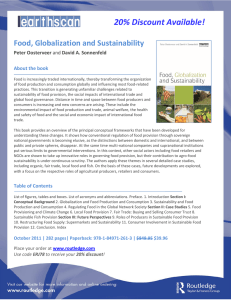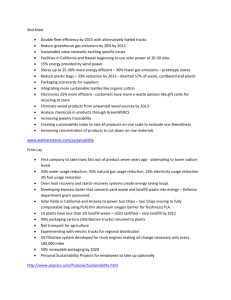“I am mindful that I need to live
advertisement
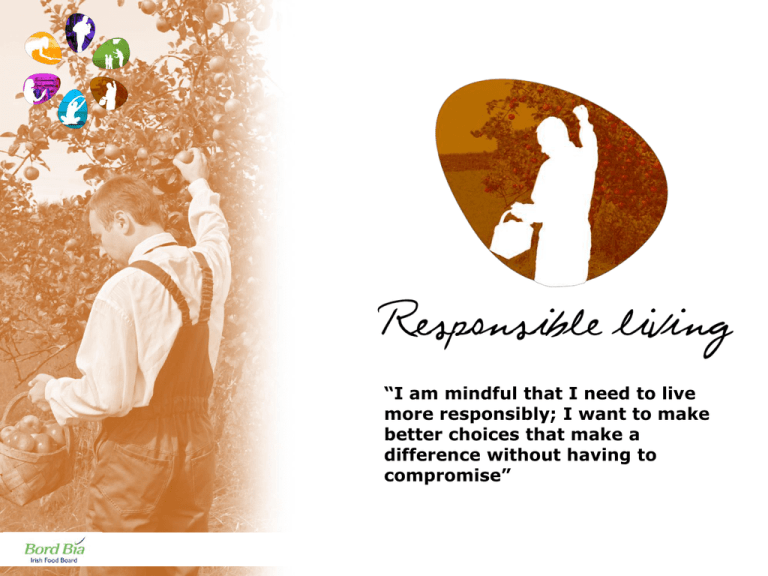
“I am mindful that I need to live more responsibly; I want to make better choices that make a difference without having to compromise” 1 “I am mindful that I need to live more responsibly; I want to make better choices that make a difference without having to compromise” • Social and environmental concerns remain of high importance for people even as the economic climate has become harsher. But high priority does not always mean the top priority and, many people seek to balance the issues of ethics and finances as well as they can. • Affordable choices and easy to do actions resonate with people wanting to live more responsibly; small things can seemingly add up into something bigger and some choices are just not worth the compromise (or the scrutiny they receive from others). 2 “I am mindful that I need to live more responsibly; I want to make better choices that make a difference without having to compromise” • When considering more responsible choices, where the outcome is more tangible, the benefit is clearer. Where the outcome leads to a local or personal benefit (as well as a wider social or environment benefit), the choice is more motivating. • Some social and environmental issues seem too hard to grasp or beyond the reach of the everyday person. As concern is heightened through either direct exposure or media attention, many people are increasingly looking toward companies and institutions to lead the way; expecting real proof of the positive impacts they claim to make. 3 For many consumers living an environmentally conscious life is important but is not a top priority „I have made it a top priority to live an environmentally conscious lifestyle1‟ (summary of top 3 boxes on 10 pt scale) % Agree 2008 2009 2010 2011 70 59 60 48 48 50 40 57 48 46 In January 2007, 57% of US voters rated the environment as a top issue for the President and Congress to deal with. That number has dropped to 43% in 2012. 41 36 34 32 33 30 31 26 24 25 20 29 27 26 21 In the same trended survey, only onequarter of voters now rate global warming as a top priority, down 13 points from five years ago.2 10 0 55 Ireland UK Western Europe USA BRIC Source: 1. Global MONITOR. See appendix for base sizes; 2. United States Pew Research Centre, January 2012 4 Key actions within people‟s control remain the primary way people engage with social and environmental issues, and often reflect a balance of good ethics and financial sense „How important are these social, environmental and economic behaviours in your personal life today? 1‟ % Agree that the below are extremely/ very in their life Reducing the amount of energy you use in your home Recycling your rubbish 100 90 Reducing the amount of water you use in your home 87 82 80 70 74 77 76 78 72 73 71 66 63 60 70 62 57 54 50 40 30 20 10 0 Ireland UK Western Europe USA BRIC Source: 1.Global MONITOR. See appendix for base sizes. 5 People are becoming increasingly sceptical of companies, expecting them to do more and demanding more tangible proof of the positive impacts they claim to make „I don't believe the claims made by environmentally friendly products1‟ % Agree . 2009 2010 2011 70 60 50 40 45 45 44 36 38 50 48 44 52 46 37 36 39 “People believe there is an ethical option. The fact these companies are doing deals with unethical businesses shows how limited their ethical commitments are. This will wake people up to how these companies‟ ethical policies are only skin deep.” 41 30 30 20 10 0 Self proclaimed ethical companies like The Co-operative, Marks and Spencer and Waitrose have come under media spotlight for their partnerships with companies such as BP, Shell and Chevron. Marks and Spencer, whose aim is to become „the world‟s most sustainable major retailer‟, has a partnership with BP, who were responsible for one the world‟s largest ever oil spills in the Gulf of Mexico in 2010. Greg Muttitt, War on Want, February 2012 Ireland UK Western Europe USA BRIC Source: 1. Global MONITOR. See appendix for base sizes. 6 Key takeaways • Social and environmental issues are still critical areas for businesses to address, expectation is rising that companies are tackling and making progress against these issues without passing on the burden of extra cost to the consumer. • Companies wishing to stand out on this agenda or build brands around social and environmental stances need to show tangible proof of their efforts to be believed, and should expect to be scrutinised for all their business impacts (not just the issues they highlight). Standing out is becoming harder as expectations increase and consumers expect more than just companies making change that makes good business sense, e.g. recycling more or reducing energy and waste. • Issues local to home resonate more strongly. Tangible benefits are appreciated especially when they can be seen to impact directly in the community and may even reward the consumer themselves. 7 Drivers Sub-trends Conserving resources Continuing economic uncertainty Growing awareness of environmental and social issues Growing impact of resource shortages Declining trust in governments and big business Living in a world where resources are increasingly in short supply War on waste Reducing the wasteful results of consumption Climate conscious Protecting the world‟s environment and biodiversity Good causes Supporting a worthy cause through purchase choices Fair treatment Treating animals and people fairly in the production process 8 SUB-TRENDS 9 HOW IS THE SUB-TREND EVOLVING? Conserving resources TOWARD Living in a world where resources are increasingly in short supply Heightened focus on saving resources with increased efficiency, particularly at the local level Peoples‟ appetite for saving resources has grown as solutions have migrated from the fringes to the mainstream, reinforced by rising resource costs. More sophisticated solutions are emerging that help people and companies use fewer resources, from packaging design to new farming methods. FROM New farming method uses a tenth of the amount of water to grow crops, Dubai Danone Brazil‟s 100% renewable plastic packaging is made from sugar cane, a locally available resource, Brazil Saving resources at the Cookit uses solar energy to heart of the product or cook food, reducing reliance brand idea and alternative on solid fuels, Global sources become mainstream Samsung‟s Blue Earth Waitrose delivers orders by bike, GB mobile phone avoids traditional power sources by using an in-built solar panel to provide its power, South Korea 10 SUB-TREND: Conserving resources Living in a world where resources are increasingly in short supply Solar cooking kit, Global The CooKit is becoming increasingly relied upon in a number of emerging markets, and areas where solid fuels are scarce. It is made of cardboard foil and is shaped to reflect sunlight onto a cooking pot where it is converted into thermal energy. A heat-resistant bag surrounds the pot, acting like a greenhouse to preventing heat from escaping. Renewable packaging, Brazil Danone‟s 100% renewable plastic packaging for its Activia yoghurts and fermented milks is made from sugar cane. In addition to using a locally available resource, its production process also ensures lower carbon emissions than traditional plastics. Water conserving agriculture, Dubai Dubai-based Agricel recently launched a farming system that uses a film-like material instead of soil and allows farmers to use 90 percent less water. Plants are cultivated in a hydromembrane composed of a water-soluble polymer and hydrogel. The membrane is said to protect against microbial attack. 11 HOW IS THE SUB-TREND EVOLVING? War on waste Reducing the wasteful results of consumption A renewed focus on making the most of what we have is emerging. Waste is becoming less acceptable across the board, and innovations are emerging to help prevent waste in the first instance. People too, are using strategies such as more effective meal planning to avoid food waste. Mos Burger recycles used oil and food rubbish into plant food, Japan Innovation and packaging design that helps prevent waste in the first place Smart fridge keeps food fresh longer and tell consumers which items are about to go off, South Korea Development of nano-silver coated packaging to extend shelf life of products, Israel FROM Closing the loop and finding ways to usefully repurpose waste TOWARD Traffic-light style food label indicates freshness more efficiently than use by dates, helping reduce food waste, UK Nescafé‟s innovative packaging to reduce carbon footprint, Global 12 SUB-TREND: War on waste Reducing the wasteful results of consumption Food freshness label, UK Open Life Packaging, a UK based company will soon launch its time, temperature and enzyme pH measuring labels. The label remains green when the product is good to consume, amber when the best by date has passed and red when the use by date arrives. This helps consumers and retailers to judge the freshness of a product and to reduce food waste. Nano coated „killer‟ paper, Israel Scientists at Bar-llan University in Israel have developed a method for quickly coating paper with anti-microbial silver nano particles using ultrasonic radiation. The process will have significant implications for creating packaging that extends the shelf life of foods by exploiting the bacteria killing properties of silver particles embedded within it. Smart fridge, South Korea LG‟s recently developed smart fridge sends alerts to consumers when food items are about to go off and suggests personalised recipes for items that should be used soon. LGs linear compression technology also helps preserve food longer. 13 HOW IS THE SUB-TREND EVOLVING? Climate conscious TOWARD Protecting the world‟s environment and biodiversity Carbon emissions continue to receive attention and media coverage is ensuring that issues such as sustainability of fish stocks are starting to appear on peoples‟ radar. Brands and retailers are responding to this by making it easier for people to make choices they can feel good about. Carbon neutral juice company reconverts its fruit waste into organic fertiliser for its own crops, Australia Smart phone app connects consumers to local farms and markets in their area, USA FROM Rising transparency around carbon impacts and a move to low impact solutions with niche appeal Acai Vodka produced from the fruits of the rainforest and supporting the rainforest, Brazil Locating low impact products more easily, and their expansion into more categories Max Burgers, a fast food chain displays the carbon impact of food items on its menus, Sweden A carbon neutral beer where the impacts have been reduced before offsetting, UK 14 SUB-TREND: Climate conscious Protecting the world‟s environment and biodiversity Carbon conscious fast food chain, Sweden Max Burgers displays the carbon footprint of its products on its menus and sources locally raised beef and chicken. It also plants 89,000 trees every year to offset its carbon impact. They showcase their ongoing efforts with the slogan “We are going to be the best burger chain in the world.” App to locate low impact food, USA MI Farm Market Finder is a free smart phone app that helps Michigan based consumers locate farms and markets in their area and buy products directly from the grower. The app helps locate the closest market, helping to minimise transportation and travel carbon impacts. Zero carbon juice, Australia Found Organic claims to be the first carbon-neutral juice company in the world. All fruit waste from the cold pressing process is converted into organic compost that is used to fertilise future harvests. They contribute funds to local carbon offsetting projects to reduce their footprint to zero. 15 HOW IS THE SUB-TREND EVOLVING? Good causes Supporting a worthy cause through purchase choices Supporting good causes through purchasing behaviour has become easier for people as more brands and retailers offer the opportunity to give something back. People are scrutinising who really benefits, and directing support to the local issues or where the benefit can be seen. TOWARD Supporting local businesses and integrating local producers into supply chains SABMiller‟s cassava beer integrates the produce of local subsistence farmers into its supply chain, Mozambique Japan promotes the localisation of agriculture in its national school feeding programme, Japan FROM Supporting issues further afield Madeine France connects with businesses helping consumers consumers to French offer support with limited effort producers to protect local Snickers offers to pay for 2.5 million meals from the proceeds of the „Bar Hunger‟ campaign bar sales, USA jobs, France Waitrose give the customer the choice of local causes to support, GB 16 SUB-TREND: Good causes Supporting a worthy cause through purchase choices Buying local to protect jobs, France Madine France is a recent initiative started by consumers that promotes the purchase of French products. Its website connects people to French producers and encourages them to buy local in order to protect local industries and suppliers in difficult economic times. Promotion of local agriculture, Japan „Chisan chishou‟ - literally, local production and local consumption - has become an important trend in Japan. The government is promoting it in the national school feeding programme. It connects schools directly with local farming and fishing communities to support local businesses and to nurture children‟s awareness of local food industries and the environment. Locally sourced beer, Mozambique SABMiller has become the first brewer to produce cassava lager. The lager, available in Mozambique, is created from the root of the cassava shrub, which is widely cultivated in Africa. The beer uses locallysourced raw materials, and offers opportunities for subsistence farmers in the company‟s value chains to generate an income. 17 HOW IS THE SUB-TREND EVOLVING? Fair treatment Treating animals and people fairly in the production process Fair treatment is moving from a niche concern impacting a few products and categories to a more mainstream movement, particularly as retailers are now making some Fairtrade product choices the default option. FROM Fairtrade is increasingly becoming a default choice and is expanding into a range of categories Walmart has recently announced plans to offer 500 fairtrade products in its stores by 2016, Global Fairtrade Finder, a crowdsourced app helps consumers locate fairtrade products in their area, USA Increased transparency and pressure on the mainstream to adopt fair practices The campaign for supermarkets and fast food outlets to adopt better welfare for chickens, UK TOWARD Clothing company works only with designers who use no animal materials and fair labour practices, Belgium McDonald‟s, now the biggest coffee seller in the UK, uses Rainforest Alliance certified coffee, GB & Global 18 SUB-TREND: Fair treatment Treating animals and people fairly in the production process Fair clothing brand, Belgium New Belgian clothing company HonestBy only collaborates with designers that are open about where their material and labour are sourced, and have a preference for no animal products where possible. In a bid to be fairer to customers too, they claim to be the first company in the world to share the full cost breakdown of its products. Fairtrade finder app, USA There are now more than 10,000 Fairtrade certified products available in the US, and the Fairtrade Finder app allows smartphone users to locate Fairtrade products in stores near their location using crowd sourced data. Walmart goes Fairtrade, Global Walmart, the world‟s largest retailer is planning to introduce 500 Fairtrade products made by 20,000 women from more than . 20 countries in its shops by 2016. Products will be one-of-akind handicrafts, such as jewellery and clothing made by women in emerging markets such as Guatamala and Thailand. 19 COUNTRY RELEVANCE How does this trend play out in Ireland and GB? Continuing economic uncertainty has been driving increasing concern with waste reduction and efficient resource use. As a result, a more responsible outlook to consumption has emerged, though not all consumers connect this directly to sustainability. Ireland • Responsible consumption has an established tradition in Ireland with a longstanding consciousness about food waste. The recessionary environment has further ingrained this trend with people increasingly looking for ways to plan meals and food purchases efficiently. • Sustainability is not a top level concern for most people, however, shoppers are willing to engage with environmental and social causes when brands and retailers provide opportunities for it. • Ireland‟s ongoing economic difficulties have further strengthened the perception that supporting the domestic economy by buying Irish is a worthy social cause. Building local and national resilience is a particularly strong dimension of this trend. Great Britain • Buying British is emerging as an important trend though for most consumers this means supporting the local economy rather than a commitment to environmental concerns, such as reducing carbon footprints. • Animal welfare is a growing concern for many people. Because of higher perceived animal welfare standards vis-à-vis the rest of Europe this also drives a preference for British products. • Fairtrade is becoming a default choice in many categories, with more and more retailers providing this choice to consumers. • Similarly to Ireland, food waste is becoming a key concern and people are looking for ways to use their food purchases with increased efficiency. 20 COUNTRY RELEVANCE How does this trend play out in Ireland and GB? Ireland Great Britain Conserving Resources Conserving resources Living in a world where resources are increasingly in short supply Living in a world where resources are increasingly in short supply War on waste War on waste Reducing the wasteful results of consumption Reducing the wasteful results of consumption Climate conscious Climate conscious Protecting the world‟s environment and biodiversity Protecting the world‟s environment and biodiversity Good causes Good causes Supporting a worthy cause through purchase choices Supporting a worthy cause through purchase choices Fair treatment Fair treatment Treating animals and people fairly in the production process Treating animals and people fairly in the production process Strength in 2012: Cooling Still warm Heating up 21 SHOPPER DIMENSIONS 22 SHOPPER DIMENSION How does this trend play out for shoppers? Retailers are adopting a holistic approach to sustainability from supply chains to store design Glimpses of the future Shoppers increasingly expect retailers to be leading the way with ethical and sustainable practices. Increasingly, this means taking a holistic, „cradle to grave‟ approach, beginning with ensuring suppliers have sound sustainability credentials, or even helping them improve the sustainability practices of their own businesses. In January 2012, Asda announced it was creating a peer to peer online collaboration space called Sustain & Save Exchange where suppliers can share best practice techniques and explore opportunities to work with the grocer. Following smaller sustainable store trials, in 2012, Marks and Spencer will launch its largest and most sustainable store to date, where the design strategy will address several sustainability issues, including; carbon, waste, biodiversity, and access across the 209,068 sq ft store. Store design is another area of focus, where a growing number of retailers are recognising the environmental impact and high energy use of formats, such as department stores. Here, innovative architecture and design is facilitating large scale sustainable retail outlets that minimise a broad spectrum of sustainability impacts. M&S flagship eco store, UK Celebrating sustainable supply, Mexico Retailers are rewarding more ecofriendly suppliers. Walmart Mexico has introduced a Sustainable Provider Award, which in 2012 was won by Unilever Mexico for the reduction of the phosphate content of their detergents and for their efforts to use water efficiently at production plants in the MexicoCentral America region. 23 SHOPPER DIMENSION How does this trend play out for shoppers? In store initiatives and smartphone apps are making it easier for shoppers to make more responsible choices Both new technologies and in-store initiatives are making it simpler for shoppers to make more informed and responsible choices in store, without having to make sacrifices or compromises. Smartphone apps such as the Good Guide (shown right) now allow products to be compared on a range of ethical and sustainability credentials at the point of purchase. In store, retailers are employing simple solutions, such as the own-brand refill station in Asda supermarkets, that encourage shoppers to reduce packaging waste and save a little money in return. Positioning in store also raises shopper awareness of the issue, as well as making it an easy choice. Retailers have a significant opportunity to encourage shoppers to behave more sustainably by offering more responsible choices as the default choice. Glimpses of the future Good Guide, sustainability rating app, USA With the Good Guide mobile app, shoppers can scan products and receive ratings on a scale of 10 about the environmental, social and health impact of over 120,000 products. Refillable packaging, UK Asda supermarkets are trialling instore refills for their own brand fabric softener. Consumers can refill their own packets in-store and the scheme reduces packaging waste as well helping shoppers to save money. 24 POINTS TO PONDER Consumer • • How could you encourage or facilitate people to use less resources in their everyday lives? How might your products or brands be made in a less resource intensive way? How could you help people to reduce the amount of waste they create? Can you support strategies such as batch cooking? • Could you make it easier for people to understand the carbon and climate impact of your products? How can this be communicated in a meaningful way to consumers who may have competing priorities? • What local causes could your brands support? Which causes would your brands have most permission to align with? Shopper • How can you better align with or demonstrate your sustainability credentials to retailers? • How can sustainability commitments be effectively communicated to shoppers in store? • What elements of your retail model be made more sustainable? E.g. reducing pack sizes by concentration to save distribution costs or moving to refill models 25
